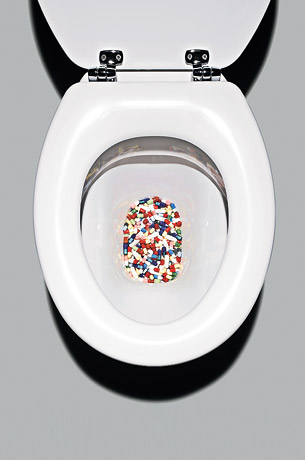
(2 of 2)
That woke regulators up fast, and numerous groups, including the EPA and the World Health Organization, began looking closely at just how thick a pharmaceutical soup our drinking water had become. Even a partial list of the drugs they found is alarming: it included antidepressants, anticonvulsants, tranquilizers, antibacterials, antipsychotics, ACE inhibitors, nitroglycerin, steroids, ibuprofen and caffeine.
But the mere fact that so many drugs have been found in the water does not mean they pose a danger. Testing techniques have become so refined that even the most inconsequential levels of contaminants cannot elude detection. "Some of these concentrations are thousands of parts smaller than what could be of pharmaceutical concern," says Robert Renner, director of the Water Research Foundation, a nonprofit group that evaluates water safety. "We're aware that they're there only because we're measuring at parts per billion."
So just how worrisome are pharmaceuticals when they're so thoroughly diluted? A study described in a recent AMWA report estimated that at the highest levels ever detected for the antianxiety medication meprobamate, a person would have to drink 1.24 million gal. (4.7 million L) in a day to ingest even a safe therapeutic dose. Not all drugs are present at such vanishingly small levels. Some are much higher, though for now they too are far below the danger threshold. More troubling, nearly all research conducted so far looks only at short-term exposure — one day's consumption of one chemical. What it doesn't take into consideration is what happens over the course of years or decades, particularly when multiple drugs interact.
The EPA acknowledges that studies on that topic must still be done but stresses that there is no reason to panic. "We are concerned but not alarmed by the very low levels of pharmaceuticals that have been detected in water," says Peter S. Silva, assistant administrator of the EPA's Office of Water. Adds another agency official: "We need more science behind this."
Whatever danger does exist, it's hard to know what to do about it. Bottled water may help a little, but it's no guarantee of safety, the EPA warns, since merely labeling a product "ultra-filtered" or "spring-water" is no proof of its cleanliness. Some risk is mitigated naturally, depending on where you live. Despite serving about 3 million people, the Chicago water system is comparatively clean. "We take our water from Lake Michigan, which is pretty pristine," says Spatz. "And our wastewater flows away." Colorado and other points west are a different matter, since many towns dot the Colorado River, and waste can flow from one to another.
Proper disposal of pharmaceuticals helps, and some communities have set up take-back centers for leftover meds in police stations and other public facilities. All those drugs are disposed of in nonpolluting ways and thus are kept out of landfills. But this addresses only about 10% of the problem. The rest comes from pharmaceuticals passing through the body and into the sewage system — a nonnegotiable pollution source if ever there was one.
For now the answer might hinge on better technology, with the EPA and other groups working to develop new cleaning techniques, improve others and lower the cost of ones that work well but are still too expensive. It's well and good if our drugs keep us healthy — but not if they make the water supply sick in the process.